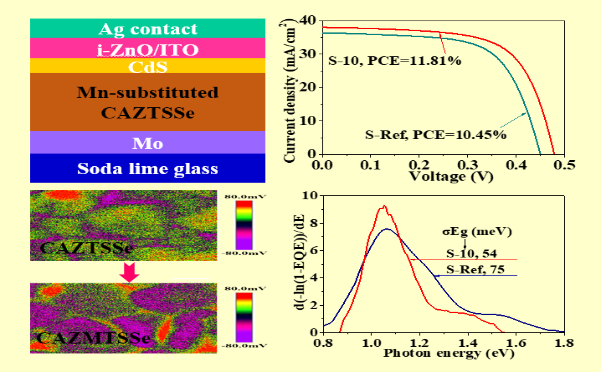Recently, Professor Wu's research group published a new research of “Synergistic Effect of Mn on Bandgap Fluctuations and Surface Electrical Characteristics in Ag-based Cu2ZnSn(S,Se)4 Solar Cells” in the Journal of Materials Chemistry A (J. Mater. Chem. A, 2020, DOI:10.1039/D0TA10103F.).
In Cu2ZnSn(S,Se)4 photovoltaic devices, the exceptionally high density of 2CuZn+SnZn donor defects may induce bandgap fluctuations and thus limit Voc and PCE enhancement. We have previously reported that partial substitution of Ag for Cu in Cu2ZnSn(S,Se)4 provides a promising way to effectively suppress CuZn defects and considerably enhance cell performance for Cu2ZnSn(S,Se)4 photovoltaic devices. However, the bandgap fluctuations and detrimental band tailing fundamentally still limit cell performance. On the basis of Ag-substituted CZTSSe system, in this paper, we demonstrate that partially substituting Zn with Mn could be a feasible tactic to pronouncedly decrease the bandgap fluctuations and prevent detrimental band tailing. Our in-depth investigation reveals that Mn substitution could increase depletion width, decrease the defect densities of CuZn acceptor and 2CuZn+SnZn donor, as well as enable the grain boundaries (GBs) inversion in (Cu,Ag)2ZnSn(S,Se)4-based cell. As a result, an impressive PCE of 11.81% was achieved when the Mn substituting level was 10%, with a Voc of 478 mV, a Jsc of 37.89 mA/cm2, and an FF of 65.23%. This is so far the highest efficiency among Mn-substituted CZTSSe-based photovoltaic devices. Our results provide a new view to suppress bulk defect and associated band tailing as well as change the transport path of photon-generated carrier for multinary compound semiconductors by cation substitution.
The first author of this paper is Doctor Yafang Qi of Key Laboratory of Special Functional Materials, and the corresponding authors are Professor Sixin Wu and Doctor Yafang Qi. This work is supported by the National Natural Science Foundation of China, the Science and Technology Department of Henan Province, and the Education Department of Henan Province.

Figure. The schematic diagram of the CAMZTSSe solar cells, J−V curves of CAMZTSSe solar cells, Surface potential maps, and Band-gap fluctuations.